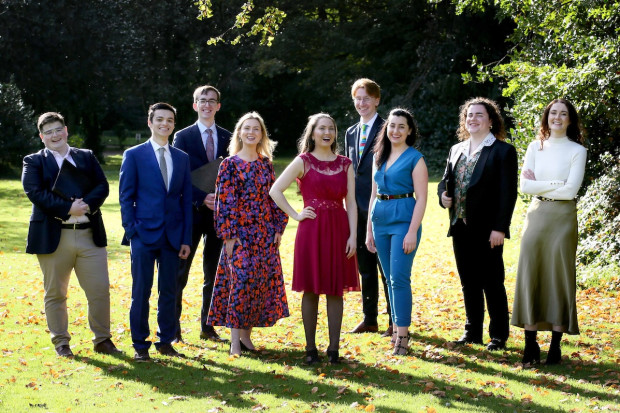
Paul Hillier and Chamber Choir Ireland at the Pepper Canister in Dublin (Photo: Chamber Choir Ireland)
Beginning with America: Chamber Choir Ireland at the Pepper Canister
Chamber Choir Ireland’s 2024 season began, in another fraught American election year, with a programme dedicated to the music of that country. ‘O My America’, conducted by the choir’s artistic director Paul Hillier, was the title of the programme performed at the Pepper Canister Church, Dublin, on Saturday 3 February, and at St Mary’s Cathedral, Limerick, on Sunday 4 February.
John Cage’s 1983 ear for EAR (Antiphonies) began proceedings, with a solo tenor on stage and the rest of the choir at the back of the church. The sung sounds are the three letters of the word ‘ear’, and in this performance it became almost a spectral work, with the R sound in particular creating rich harmonics in the church.
The concert was inspired by the musical tradition of America around the time of the American Revolution, and the first half featured four composers from the eighteenth and early nineteenth century: William Billings, Abraham Wood, Justin Morgan, and Jeremiah Ingalls. This music was written largely for amateur choirs, and so is perhaps less technically demanding than much of Chamber Choir Ireland’s repertoire, but it is bright and positive, as the composers strove to create a new musical identity for the country’s now-independent European colonisers. This is a period of music that seems to hold a particular fascination for Hillier, who has recorded several of these works before.
In 1976, for the bicentennial of American independence, John Cage wrote Hymns and Variations based on hymns by Billings. This concert paired Cage’s ‘Hymn A’ with Billings’ ‘Old North’, from which it derives. It takes Billings’ hymn and sublimates it, subtracting almost all of the material through Cage’s chance techniques until vapours of chords and vowel sounds float in the silence. The pairing was intriguing, not least because of how little of the Billings remained evident in the Cage.
Blake Songs and Proverbs
The Cage songs were the only presence of the twentieth century in the first half of the concert, but new music was the main feature of the second, with Hillier’s own substantial To see a world: Songs and Proverbs of William Blake acting as a bridge. This was the only non-American work in the programme, though written when Hillier was living in California. While sometimes harmonies flowed from one song to the next, ultimately each of the ten songs inhabited a distinct sound world, from ‘Proverbs of Hell (ii)’ enunciated over a quiet chord, to the dense texture of ‘The Rose’, to the almost sing-song ‘Tyger’.
After Hillier’s work were a variety of twentieth and twenty-first century pieces, including the conductor’s sung arrangement of the Steve Reich standard Clapping Music and works by Michael Gordon and Julia Wolfe, founders of Bang on a Can, alongside Christian Wolff’s complex, plaintive Evening Shade, Wake Up.
Reich wrote Clapping Music as a more approachable application of the phasing technique he was exploring in the 1960s, omitting the slow de- and re-synchronisation that defined the technique and instead abruptly moving from one rhythmic combination to the next. Hillier’s arrangement embraces that accessibility, using a short sung phrase rather than a clapped rhythm. It’s effective, although in its simple brightness it felt a little out of place amongst the three more sombre works in the latter part of the concert.
In particular, the most powerful and affecting piece in the programme followed it immediately. Commissioned by Hillier’s ensemble Ars Nova Copenhagen, Michael Gordon’s He saw a skull unfolds as a meditation on the cycle of violence, built on triads that overlap and glissando slowly until the full (short) text is finally revealed – ‘He saw a skull floating on the water. He said to the skull, “Because you drowned others, they drowned you. And they who drowned you will themselves be drowned” ’ – before the music expands into broad chords in the closing section.
Chamber Choir Ireland always sing incredibly, their sound rich and with unparalleled precision and control. Their musicality is matched by an adventurous spirit in programming. The use of Cage in this concert was an effective contrast with the eighteenth-century music, and with ‘Hymn A’ integrated enough with the Billings to make the subsequent return to older harmonic language more jarring than its departure. In some ways, however, although every piece was extremely well performed, the sequence overall felt less cohesive than the choir’s work usually does. An idea as big as America is hard to condense, and a concert like this strains at its one hour duration (a duration aspirational for the programme; it ran long even with a Morton Feldman work omitted for time). But a spectrum of music as broad as this also shows this flexible, virtuosic group excelling no matter the style, and it does mean that there is something for any curious listener.
For upcoming Chamber Choir Ireland concerts, visit www.chamberchoirireland.com.
Subscribe to our newsletter.
Published on 8 February 2024
Brendan Finan is a teacher and writer. Visit www.brendanfinan.net.















